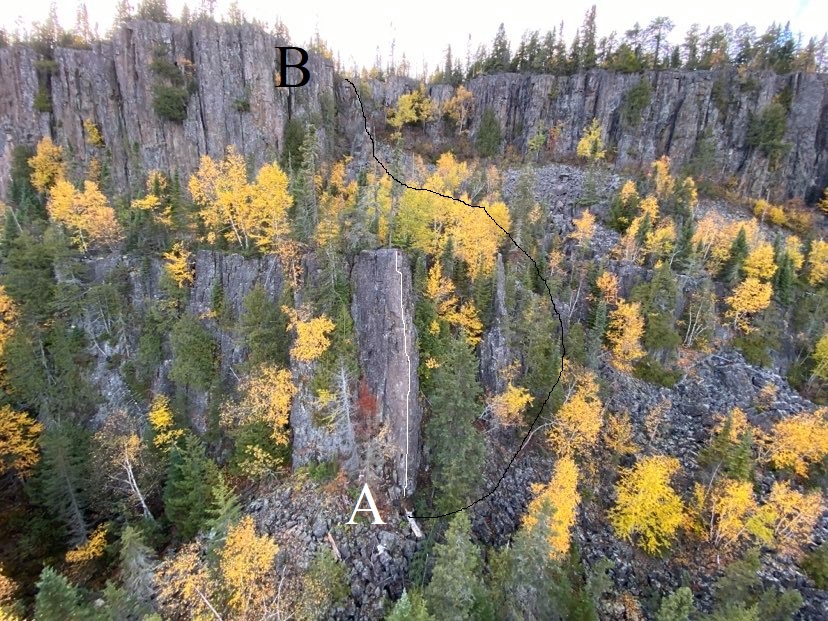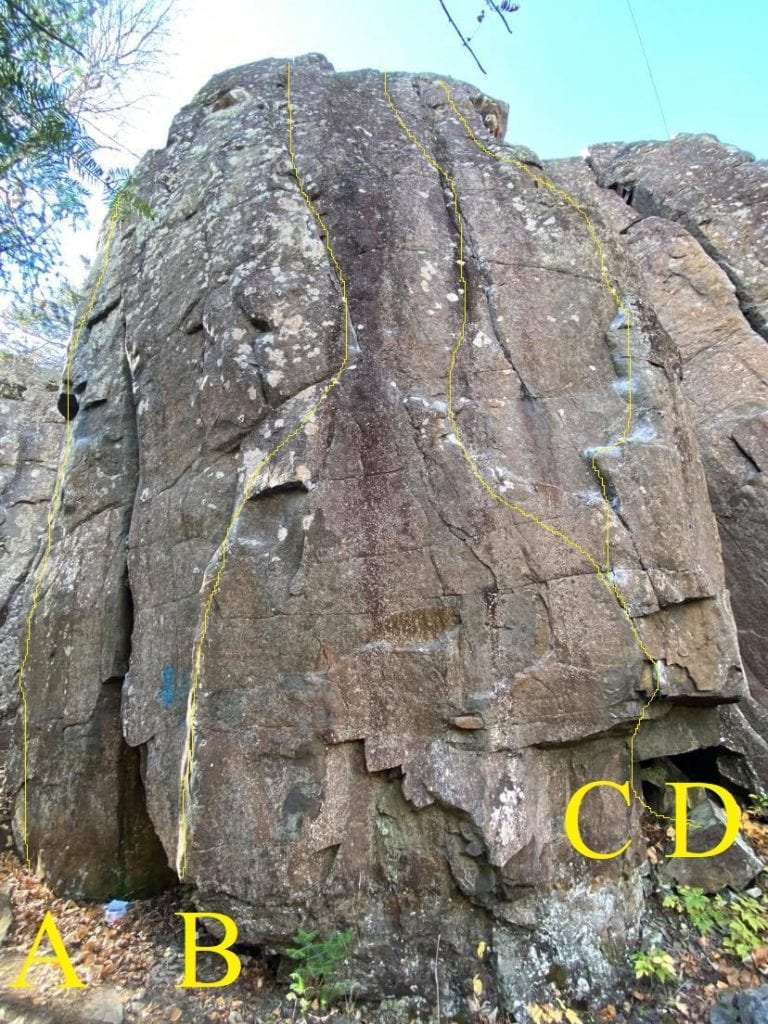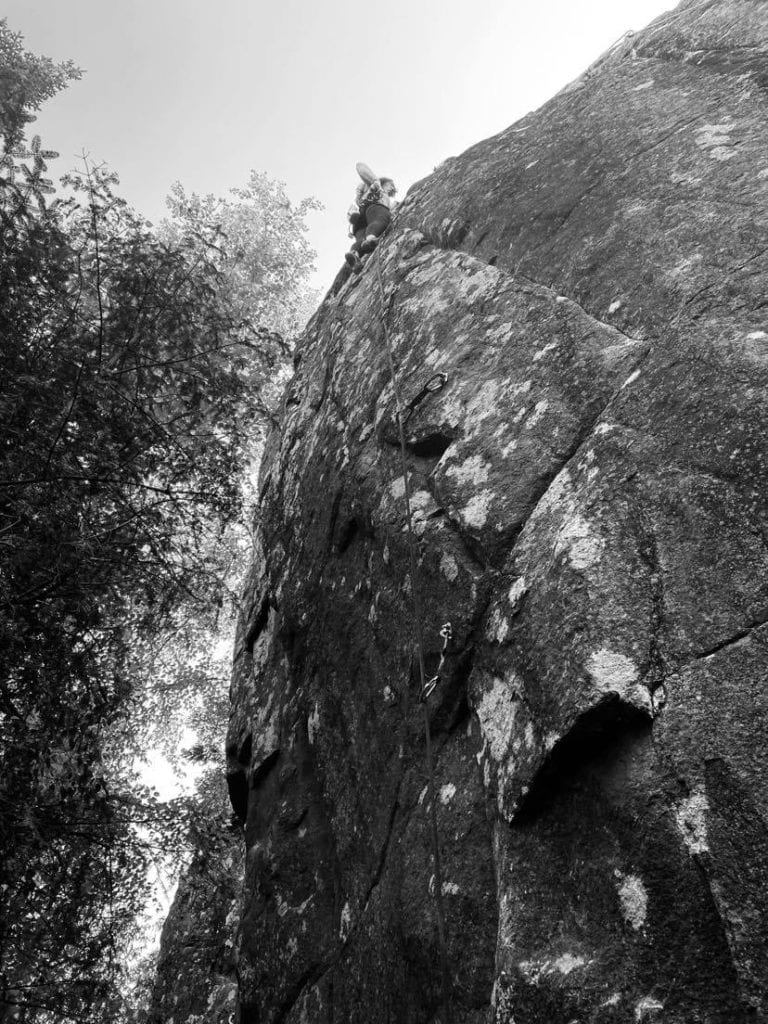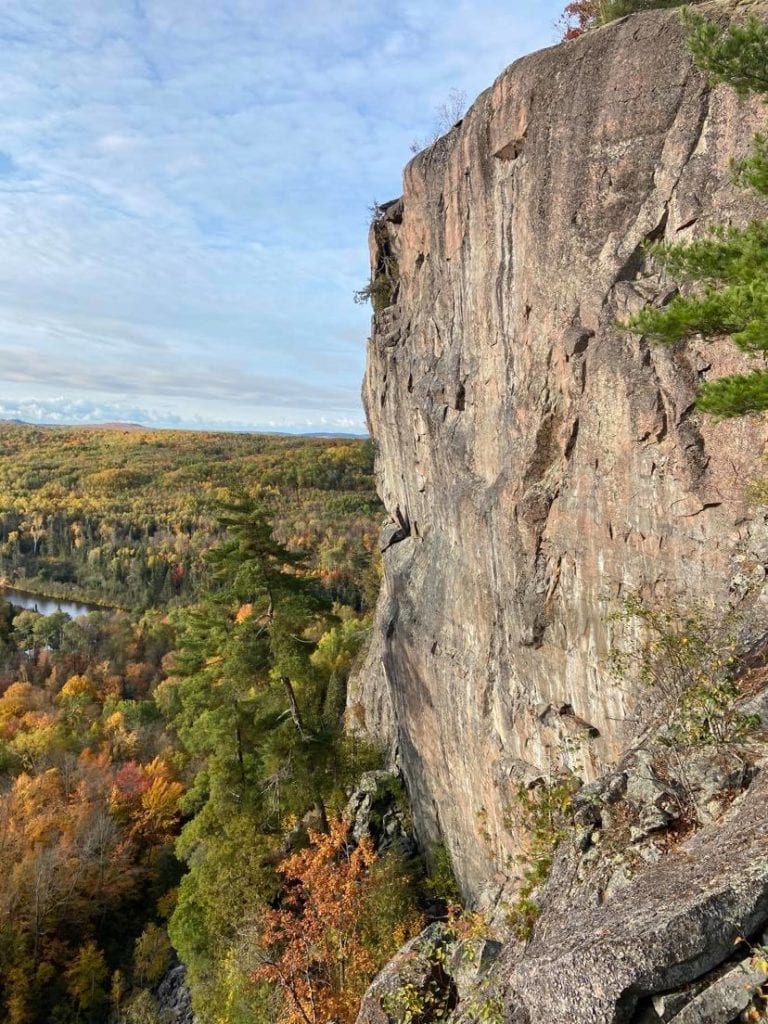Bolting New Routes in Northern Ontario in Fall 2020
Fall colours, lichen, new routes and rediscovering old classics between Sudbury and Thunder Bay
 Photo by: Brandon Pullan of Dave Smart on Riverside Wall
Photo by: Brandon Pullan of Dave Smart on Riverside Wall
Northern Ontario has a lot of rock and much of it remains unclimbed. From Parry Sound to Kenora, crags to “big” walls dot the landscape between remote lakes and famous rivers.
This fall, I travelled from western Canada to rediscover my old stomping ground, clean a new six-pitch project and add a moderate to a classic area. If you’re looking for somewhere to visit for some amazing autumn climbing, Northern Ontario is the place.
Canyonlands
During my first visit to Dorion Tower in 2000, a few friends and I dropped a rope down an arete that faces the tower and ran some laps. It was always one of those routes that I thought would clean up into a nice line.
This fall, I returned with a wire brush and crowbar to unearth a route far better than I remembered; and even though it’s just shy of 25 metres, it took five hours to clean. The lichen and loose blocks require patience to scale off the walls around Lake Superior.
I named the nine-bolt 5.8 arete Canyonlands. Jared Miller from Thunder Bay made the trip out to make the first ascent with me. We followed it up with his first time up Dorion Tower.
I think it’s a great addition to the canyon and gives climbers another option while waiting in line for The Canine. Last weekend, there were 20 people at the base of Dorion Tower waiting for their turn.

Dorion Tower was first climbed by Shaun Parent and Peter Powell in 1986 via The Canine, a 5.6 trad route up its western edge. The tower stands in one of the many canyons northwest of the town of Dorion south of Nipigon.
They call this area the “canyonlands of Ontario” and it’s one of the most unique places west of the Rockies. A number of other trad routes were climbed in the area, but they’re all overgrown and likely never repeated.
The first time I climbed the tower was 20 years ago, with a group of 20 fellow university students. You can read more about the one-of-a-kind feature here.
Ouimet Canyon is the most famous of the canyons and has arctic plants only found 1,000 kilometres north. Another is Eagle Canyon, which used to be flooded for ice climbing, like Ouray in Colorado, and has walls up to 60 metres.
Thunder Bay Bluffs
The Thunder Bay Bluffs are 50 feet high at their highest and extend for over a kilometre from the parking area near Boulevard Lake towards a large powerline corridor. Some of the first routes established were back in the 1960s, when students attending the newly formed Lakehead University began exploring the area.
The basalt rock features splitter cracks and excellent edges. There’s a trail along the top and a faint one along the bottom. Over the past 15 years, a lot of graffiti has been distastefully added to the base of some climbs.
I cut my teeth at the Bluffs on the burly cracks back in the day. The trad routes were legendary, but many are now overgrown or full of broken glass and trash. The area has fallen, mostly, into disrepair.
In the 1990s, a few routes were bolted for lead climbing, including Galaxian 5.10b and The Flying Dutchman 5.12a. They were both chopped by locals insisting that the crag should only be a top-rope/trad crag.
Galaxian has been lead on gear, including by Jason Thorne in the early 2000s, and rumours of it being soloed have circulated for years.

The top-rope anchors along the cliff are a complete mess, with random bolts added to the flat top near the hiking trail. Hikiers often trip on the bolts.
Local clubs advise climbers to carry five to 10 metres of webbing to rig complicated anchors off old trees where no bolts exist. For 20 years, I’ve been watching climbers rig weird and dangerous anchors in places where modern two-bolt anchors could be used.
Dallas Markall, owner of the local climbing gym Boulder Bear, offered to join me for a day of bolting at the Bluffs; to fix anchors and re-bolt the old climbs. His daughter, Taryn, 16, is an absolute crusher and recently made the first free ascent of one of the area’s hardest routes.
Markall and I were joined by Shasa Alexandriw, manager and head routesetter of Boulder Bear, for the Bluffs bolting day. We visited the Powerline Tower, an area that had no climbs that could be safely led, but had the highest walls at the Bluffs.
Markall re-bolted The Flying Dutchman and upped the old three-bolt count to five bolts. Alexandriw and I bolted two new routes. I’ve dubbed one route Invincible and one Captain Kool.
Invincible follws a bulge to the seam of Hookenbladen, a likely unrepeated A3 from the 1990s with a fixed bashy. It’s one of the most exciting free projects in the area. Alexandriw has it down to two falls and suggests that it will be 5.12+.
Captain Kool starts on Sick and Afflicted 5.12b and climbs past a small roof and up an arete. It joins an old A2 called John and Ponchareli. I trundled some big rocks off. Aric Fishman made the first free ascent of Captain Kool, followed by Taryn, who suggested 5.11b.

Sick and Afflicted is a top-rope climb that was led once by Mitch Marostica, who soloed the crux to get his first piece in the thin crack about 20 feet off the deck. It would make for a five-star sport route, but because it’s been led, I left it alone.
The Flying Dutchman is named after the steamship Bannockburn, a steel-hulled freighter that disappeared on Lake Superior in 1902. The wreck of the ship has never been found and it gained the reputation as a ghost ship known as The Flying Dutchman of the Great Lakes.
I named Invincible after a wooden ship that was employed in the fur trade by the Northwest Company. It sank in a storm and is considered to be the first recorded ship to sink in the Great Lakes.
I named Captain Kool after Captain Myrtle ‘Molly’ Kool, a Canadian sea captain from New Brunswick. She’s recognized as being one of the first North American registered female sea captains and the first female Master Mariner in Canada.
Routes should never have been chopped and the Bluffs deserve to be a more respected crag than they are. Hopefully the graffiti gets cleaned, the anchors fixed and more routes re-bolted. The dozens of classic trad routes will always be there, but the Bluffs should be the centre of Thunder Bay climbing, once again; and safer routes will help with that.
Four weeks after bolting Flying Dutchman, Invincible and Captain Kool, I was happy to return to find them chalked up from the bottom to the top, as they’ve been getting climbed.

Riverside Wall
From Sudbury to Wawa are dozens of crags and bigger walls that have been getting a lot more attention over the past few seasons than in the past four decades. New single-pitch routes up to 5.12 and five-pitch adventures up to 5.10 have been developed.
Dave Smart, the editorial director of Gripped Publishing, invited me to check out a new wall that he recently opened called Riverside. It’s along the road to the now-famous Eyeball over the Little White River north of Iron Bridge.
Riverside, also known as Shotgun, didn’t have any routes before 2020. Smart, along with his brother Reg Smart and Ontario legend John Kaandorp, bolted Bullets Before Breakfast. The five-pitch 5.10a follows a few short walls to the North Channel Ledge and on to the upper wall. Since the first ascent this summer, it’s been getting climbed every weekend.

Randy Kielbasiewicz and Rafael Kolodziejczyk have since added Starry Nights, a wild six-pitch 5.10, up one of the central walls at Riverside. There are at least two other projects in the works on the wall.
Smart and I visited for the weekend of his 58th birthday with a bag of gear and four batteries-worth of bolting. We worked on a line Smart had found earlier this year; it turned out to be one of the best big lines that I’ve ever worked on.
In the end it will be six pitches up to 5.10. We named it Long May You Run, a Crosby, Stills and Nash song, which includes lyrics about Blind River; a town close to Riverside Wall.
The area is crown land, but you need to pay to access the road via a private residence. Once in the backcountry, you can camp anywhere, fish the river and have big wall-style adventures. Smart and I will have to return in the spring to finish the route.


